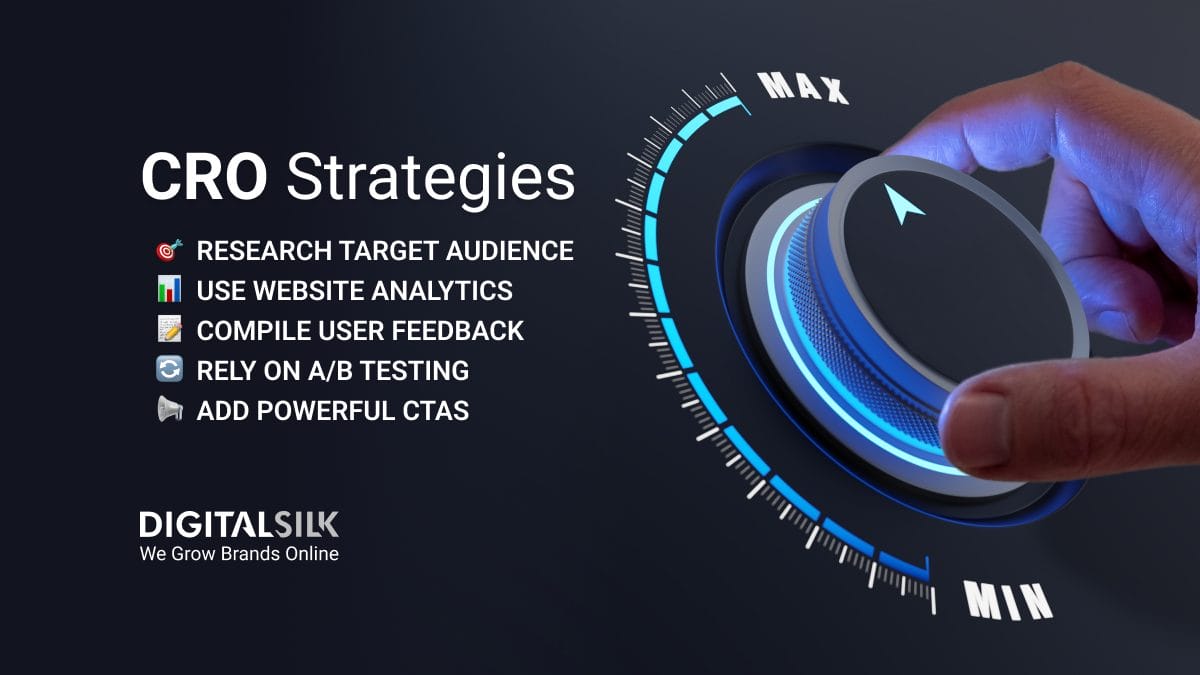With 5.24 billion active social media users, platforms like LinkedIn, Instagram, Facebook and X play a crucial role in shaping consumer decisions, influencing purchasing behavior and providing direct access to target audiences.
However, many brands still approach social media as an afterthought instead of recognizing it as a key engine for business growth. This oversights its potential to strengthen brand identity, increase engagement and deliver measurable Return on Investment (ROI).
A strong social media branding strategy goes beyond merely posting content; it involves creating a cohesive brand presence, building long-term trust and aligning your digital narrative with your business goals.
In this guide, we will outline an eight-step framework that helps you develop a powerful, results-driven social media branding strategy designed to maximize impact and fuel business growth.
8 Steps To Creating A Social Media Branding Strategy From Scratch
A social media branding strategy ensures that your messaging, visuals and customer interactions align with your brand’s core values, mission and business objectives.
Here’s how to create a successful social media branding strategy step by step.
Step 1: Choose Your Social Media Networks
When starting, it’s important to consider what you’re expecting as a business on social media.
More likes, shares, comments and engagement, right?
Engagement doesn’t just happen as you start posting. Your content marketing strategy should evolve according to the audience you want to target.
The first thing you have to do is create a buyer persona.
Dig deep into the demographics of your target audience, including:
- Age
- Location
- Gender
- Average income
- Industry
- Interests
When you have a specific buyer persona in mind, you can match that with the audience demographics prevalent on social media platforms.
For example, if your target audience is on Instagram more than any other platform, then investing all your efforts in Instagram marketing will be a wise choice.
To guide you further on how to choose platforms for your social media marketing plan, here is a list of major social media platforms and usage trends based on age groups.
Step 2: Update Your Profiles With Consistent Messaging
After choosing social media platforms relevant to your business, this is the first step toward your social media branding. Leave nothing to chance and fill up all the details required on each platform.
Consider your social media profile as your resume and update your details regularly (including your cover photo, profile picture, bio, website link, etc). This will reflect professionalism and help potential customers see a clear overview of your business reputation.
Now, let’s get into the details.
Remember that your social media branding on each platform should be consistent, to show that it’s the same brand across all platforms.
For example, if you have a Facebook business page and an Instagram business account, your profile picture on both platforms should be the same. This way it’s easier for users to find you.
Brand consistency makes it easier for users to find you and recognize your brand across different platforms.
Just like your visuals, your messaging should remain consistent.
When it comes to your business bio, keep these tips in mind:
- Be concise: most platforms have word limits
- Stay original: this can help users to relate to you
- Speak to your target audience: after all, this is the main reason you’re on social media
Step 3: Find Your Brand Voice
The primary goal of a social media branding strategy is to engage users and make them a part of your digital sales funnel. But, in order to engage users, your brand has to stand out to catch their attention.
Wondering what can make your brand stand out?
It’s pretty simple.
Stop sounding promotional and start sounding human. Keeping your business’s mission in mind, think of how your brand would sound if it were a human.
To lead you further, define your brand with adjectives to determine how you should sound to your audience. Here is an example:
- Passionate
- Quirky
- Authentic
If your brand has any of these brand personality adjectives, you can start digging into your adjectives. Here is how you can do it:
- Passionate: expressive, enthusiastic, action-oriented
- Quirky: unexpected, different, irreverent
- Authentic: trustworthy, genuine, direct
It’s also important to consider which adjectives align with your industry. Here are some guidelines you can follow to ensure they reflect the values, tone and expectations of your field:
| Brand Type | Tone & Style |
| Luxury Brand | Sophisticated, aspirational, exclusive |
| Tech Startup | Innovative, energetic, solution-focused |
| Healthcare Provider | Trustworthy, empathetic, informative |
| eCommerce Brand | Friendly, engaging, community-driven |
Lastly, you can look at social media profiles of some of the biggest brands in the world and analyze their tone, word choice and how they position themselves in the industry.
For example, here’s how @tacobell uses its witty and irreverent brand voice on social media:
Step 4: Create Visually Cohesive Branding Across Platforms
Your social media presence should be instantly recognizable.
This means using:
- Consistent color schemes
- Branded templates for graphics and posts
- Unified logo placement and typography
- High-quality visuals and video content
With a cohesive and easily-recognized social media presence, you’ll be able to build trust, strengthen identity and make your content more memorable to your audience.
Social media algorithms prioritize video content, so consider creating short-form videos, motion graphics and branded animations.
For example, Coca-Cola’s social media branding is instantly recognizable due to its signature red, dynamic imagery and lifestyle-driven content.
Step 5: Focus On Community Building And Engagement
Cultivating a strong community around your brand fosters loyalty and encourages word-of-mouth promotion. This isn’t something you can achieve if you only post promotional content and neglect genuine interactions.
Instead, you need content that educates and entertains your audience. Think about what your followers would like to learn about or what kind of problems they’re facing. Help them find solutions and post content that adds value to their lives.
Sometimes, a post that gets a laugh out of a follower can mean more than a series of promotional messages, as it humanizes your brand and makes your audience feel more connected to it.
Also, respond to comments, messages and mentions regularly to show appreciation and attentiveness.
Step 6: Build A Consistent Social Media Presence With A Posting Strategy
We have reached the execution part of your social media branding strategy. And here is when you will decide on how often you want to post, when you should post and what you should post.
Well, there is no ironclad answer to this.
It depends on what business you have and which audience you are targeting.
The best thing you can do is to start experimenting. Allow yourself 2-3 weeks at a time to experiment with posting different types of content at different times and keep tabs on the posts that are generating the most engagement.
Fill up your social media calendar with different types of content each day and then work more on the content that drove the most engagement.
When starting out, you can rely on peak engagement periods on the platform for your industry and type of business. Below is a schedule you can use to time your Instagram posts based on your specific needs:

Step 7: Implement A Data-Driven Content Strategy
To maximize engagement and impact, your content strategy should include data and audience insights. Identify the type of content that resonates best with your followers and find ways to present valuable information in compelling and digestible formats:
- Pillar Content: Long-form, high-value posts (case studies, whitepapers, guides)
- Micro-Content: Bite-sized insights (quotes, stats, carousel posts)
- User-Generated Content: Reposts of customer testimonials, product experiences
- Live & Interactive Content: Webinars, Q&As, polls, Ask Me Anything (AMAs)
Step 8: Monitor Performance And Optimize
A successful social media branding strategy is data-driven and constantly refined.
To keep a detailed track, you need social media analytics. There are several key metrics you should monitor to better understand your performance and optimize your strategy:
- Engagement Rate: How actively users interact with content
- Follower Growth Rate: Indicates brand visibility and reach
- Brand Mentions and Sentiment: Tracks perception and reputation
- Conversion Rate: Measures social media-driven lead generation
Most of the social media platforms have inbuilt analytics in their site but they are typically pretty basic. Luckily, there are plenty of social media analytics tools available online. The most popular options include:
- Sprout Social – Offers comprehensive analytics, social listening and performance insights.
- HubSpot – Provides in-depth social media tracking and additional marketing tools.
- Google Analytics – While primarily used for website traffic, it can track social media referrals.
These tools can break down your posts and give you valuable insights into user engagement. These insights can in turn help you work on your social media branding strategy and win over more customers.
Key Considerations For Strengthening Your Social Media Branding Strategy
Beyond these key steps for building a strong social media branding strategy, there are several advanced tactics you can use to reinforce your brand’s reach and credibility.
These elements can play a role in shaping a more robust and impactful presence on the platforms you decide to use.
Let’s look at how you can employ these strategies and integrate them into your strategy:
Leverage Employee Advocacy For Greater Brand Visibility
Your employees can act as your most powerful brand ambassadors. You can encourage them to share company content, the industry insights you post and their own experiences with your brand.
Start by educating your team on best practices, branding guidelines and ethical considerations when discussing the company online.
Acknowledge employees who actively promote the brand and consider incentives such as bonuses and recognition programs.
With a good employee advocacy program, your brand also becomes a more attractive place to work, making it easier to draw in top talent.
Starbucks has one of the most famous employee advocacy programs, with the company’s workers sharing their experiences and workplace culture on social media pages. It is called Starbucks Partners. The dedicated Instagram page for its employees has grown to over 180,000 followers.
Protect Your Brand Reputation With Crisis Management
A single negative experience on social media can quickly escalate and damage your brand’s expectation. In situations like that, having a crisis management plan is essential to maintaining trust and credibility.
You can assign response teams, prepare predefined protocols and create templated responses for various scenarios.
Social listening tools can help you track brand mentions and detect any potential issues before they escalate.
Once an issue has been resolved, follow up with affected users and communicate any long-term improvements made based on their feedback.
Six Reasons Why Social Media Marketing Is Important For Your Business
If you still need convincing on why your business requires a solid social media branding strategy, consider these six key reasons.
1. You Get A Platform To Tell Your Story
Social media is a place for seeing what other people are up to and connecting with them. But for businesses, the connecting part doesn’t come very quickly. It requires users to trust them.
And for users to trust you, you have to tell people your story because your story is how your customers will remember you. And social media can be the best place to do that.
2. You Can Grow An Audience With Even A Small Budget
Social media branding is the least expensive way to market your business while providing the most massive potential audience.
Rather than spending money on promotional ads, you can simply start by posting engaging content consistently. This requires zero investment, and you still have a reach to millions of people.
3. You Can Easily Increase Your Brand Awareness
Creating unique and visually appealing content that can catch users’ attention can kickstart your brand awareness game on social media.
But that’s not all.
You have to keep reminding your audience that you exist. And with regular posting on social media, your audience will slowly but steadily start remembering your products/services when in need.
You could even create a podcast that you can then promote via social media. Tease episodes on Facebook or Instagram, or post snippets on YouTube. This could bring in a whole new audience for your brand.
In order for your brand to be considered a pro in the industry, you also need to upload only high-quality banners or images, which can be created with the help of a web designer.
To make a great impression right from the start, consider looking into how to hire a graphic designer. There are many specialists available, but not all of them have the right skills, experience, and will to evolve with the brand.
4. You Get To Learn About Your Competitors
With business profiles all over social media, this can be your chance to keep an eye on your competitors.
For example, you can take note of what type of strategy they are following and how it’s driving traffic for them, along with factors that may be lowering their engagement, questions their audience is asking and more.
Incorporating these insights into your social media marketing strategy can bring substantial benefits. Make a habit of regularly checking competitor posts, campaigns, comments, engagement rates and other factors to ensure you’re always a step ahead of the game.
5. You Can Choose To Build Custom Audiences
With over 60% of the world’s population being on social media, it is definite to say that it has various audiences. But targeting a relevant audience on a detailed demographic level is best done on social media because of its extensive features.
And the best part about it is that it’s so much better and easier than traditional marketing techniques. There are numerous opportunities to narrow down and reach your target audience on social media platforms.
6. You Can Increase Company Profitability
While social media has great branding capabilities, it can also be extremely valuable to assist your company in its goal of increasing revenue.
Whether you’re using an Instagram account to increase the sale of courses that you’ve built with a quality online course builder, or you’re earning passive income from a YouTube channel’s ads that you’ve built for your food blogging business, social media can enhance your company’s balance sheet.
By now, you might be pumped up to get started with your social media branding strategy. So let’s review a step-by-step guide on how to create a branding strategy from scratch.
Takeaways On Social Media Branding Strategy
So, what’s next?
Are you ready to put your social media branding strategy into action?
Remember, a well-thought-out strategy doesn’t bring business growth until executed in the right way. So after you have the theoretical framework ready, start implementing.
Let us know in the comments section below about how you created your social media strategy from scratch and the ups and downs you experienced.
Good luck with your social media branding!
How To Create A Social Media Branding Strategy – FAQs
Social media branding is crucial as it helps your business reach a broader audience and establish authority. A strong brand presence also fosters engagement, strengthens customer loyalty and enhances long-term retention.
To ensure consistency you have to outline standards for your visuals and messaging on social media. It’s also important to maintain regularity by planning and automating your posts.
Content plays a key role in your social media branding strategy as it shares your mission and values, encourages interaction with followers and positions your brand as a thought leader.
To differentiate your brand on social media, it’s important to create a unique visual identity that can help your content stand out in a crowded market. Additionally, come up with messaging and tone that aligns with your target audience and maintain consistency across all platforms. You can also explore unique content formats such as behind-the-scenes footage, user-generated content and live streams.
You can keep track of the success of your social media branding efforts by analyzing engagement metrics such as likes, shares, comments and mentions. In addition, monitor your follower growth and evaluate referral traffic from social platforms.
Regular updates are essential if you want your social media branding to work. Assess performance and adjust your tactics quarterly and revisit it when launching new products or rebranding.
"*" indicates required fields









